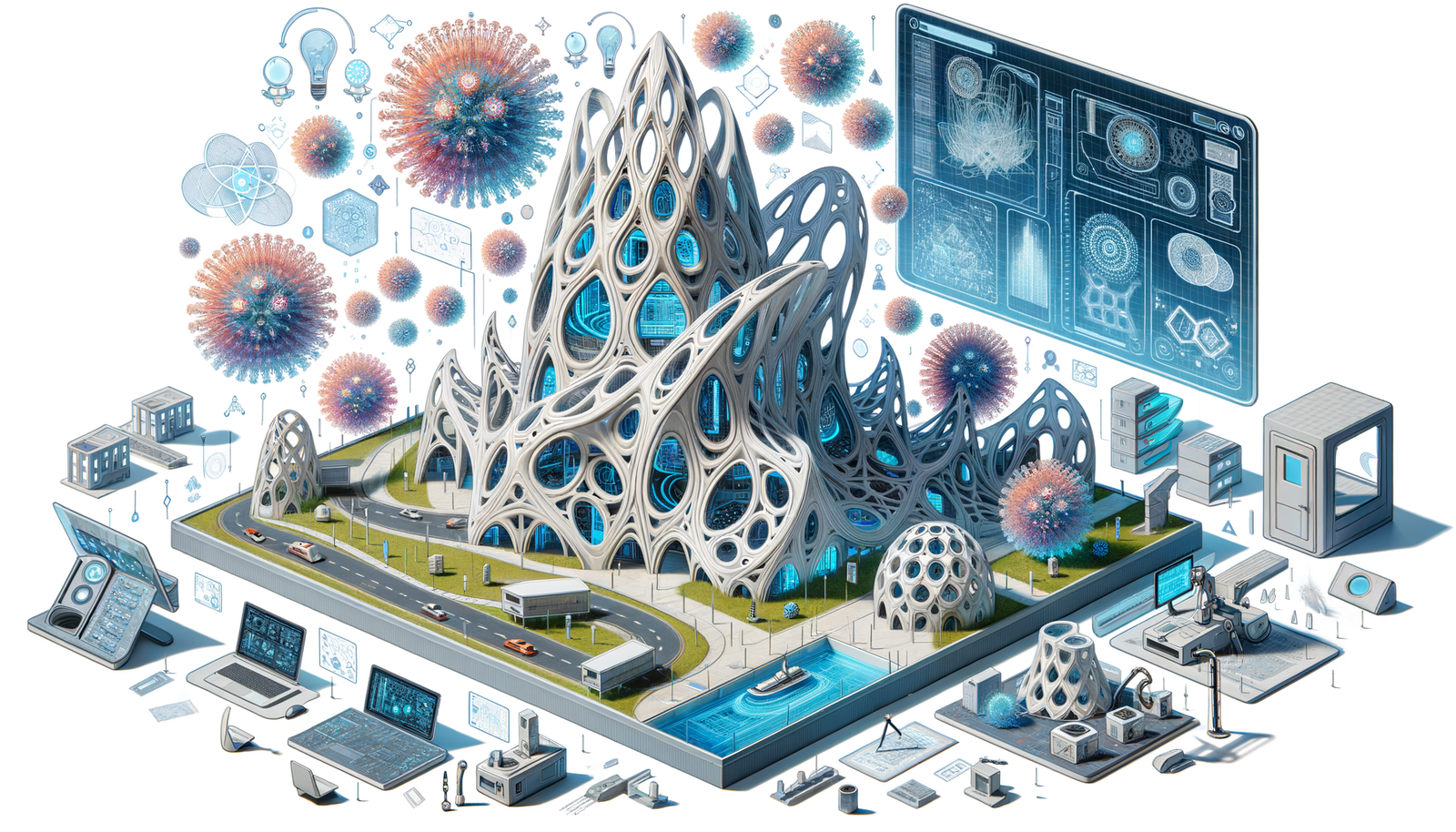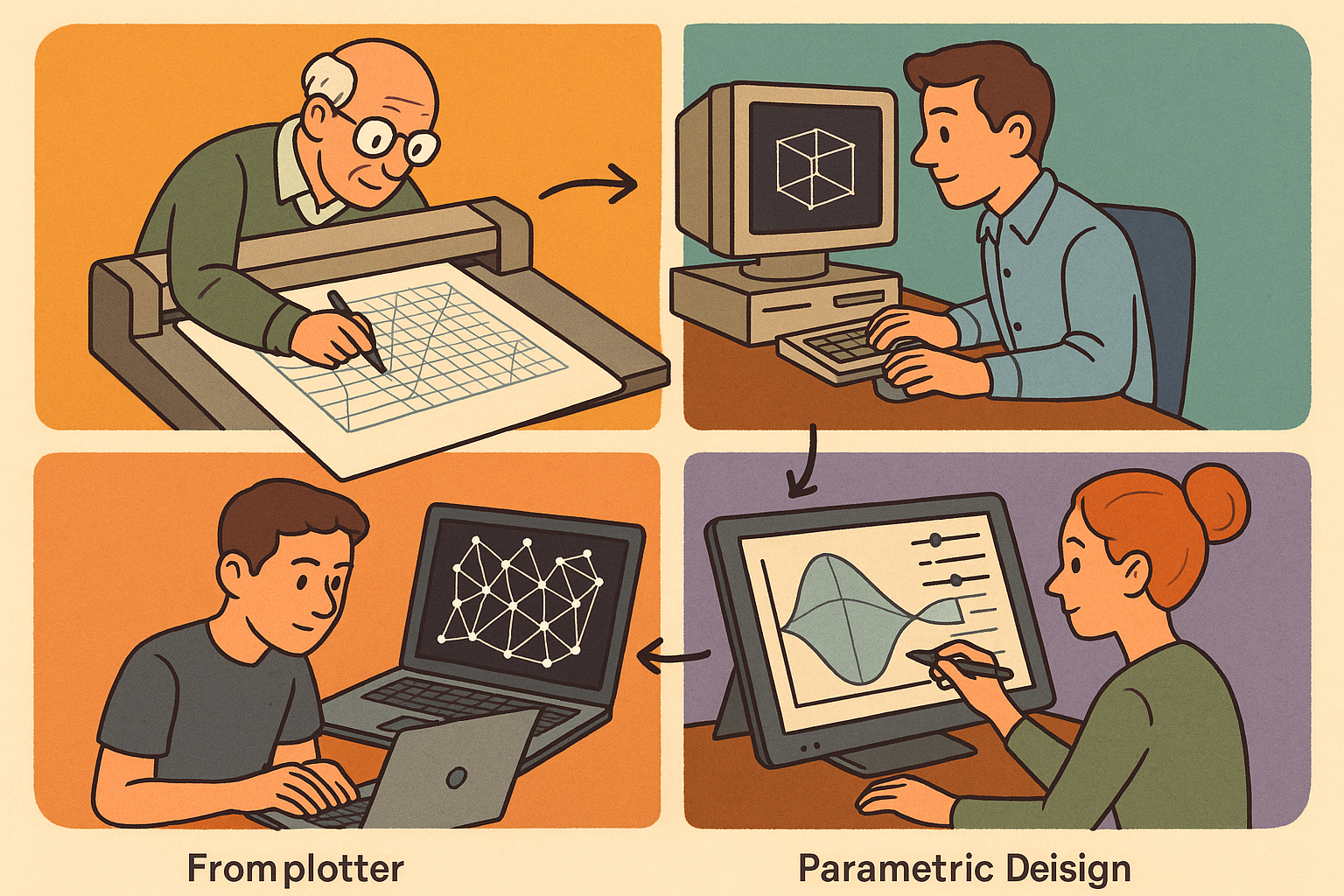Your Cart is Empty
Customer Testimonials
-
"Great customer service. The folks at Novedge were super helpful in navigating a somewhat complicated order including software upgrades and serial numbers in various stages of inactivity. They were friendly and helpful throughout the process.."
Ruben Ruckmark
"Quick & very helpful. We have been using Novedge for years and are very happy with their quick service when we need to make a purchase and excellent support resolving any issues."
Will Woodson
"Scott is the best. He reminds me about subscriptions dates, guides me in the correct direction for updates. He always responds promptly to me. He is literally the reason I continue to work with Novedge and will do so in the future."
Edward Mchugh
"Calvin Lok is “the man”. After my purchase of Sketchup 2021, he called me and provided step-by-step instructions to ease me through difficulties I was having with the setup of my new software."
Mike Borzage
Design Software History: Algorithmic Design in Architecture: Transforming Creativity and Efficiency Through Computational Innovation
November 08, 2024 5 min read


Introduction
Algorithmic design is a transformative paradigm in architecture that utilizes computational algorithms to conceive, generate, and manipulate complex architectural forms and structures. In the context of modern architecture, it transcends traditional design methods by introducing a systematic and logical approach to form-finding and problem-solving. The significance of algorithmic design lies in its ability to handle intricate geometries and massive datasets, allowing architects to explore design possibilities that were previously impractical or impossible. By leveraging computational power, architects can simulate environmental factors, optimize structural performance, and customize designs to specific site conditions and user requirements. This integration of algorithms into the architectural workflow not only enhances creativity but also improves efficiency and precision. The evolution of design processes influenced by algorithms reveals a shift from manual drafting to parametric and generative design methodologies. Early adoption of computational tools marked the beginning of this transition, but it is the advancement of algorithmic design that has substantially broadened the horizons of architectural practice. The importance of algorithms in optimizing and innovating architectural solutions is evident in the way they streamline complex calculations, automate repetitive tasks, and enable the exploration of a vast array of design options. This empowers architects to focus on conceptual development and design refinement, ultimately leading to more innovative and sustainable architectural solutions that are responsive to the dynamic needs of society.
Historical Context of Algorithmic Design
The historical context of algorithmic design in architecture is rooted in the early integration of computational technologies into architectural practice. Pioneering architects like Frank Gehry revolutionized the field by employing Computer-Aided Design (CAD) systems to achieve complex forms that challenged conventional construction techniques. Gehry's use of software such as CATIA, developed by Dassault Systèmes for the aerospace industry, enabled him to design and realize iconic structures with fluid, titanium-clad curves. This marked a significant departure from traditional architectural methods and signaled the potential of computational tools in architectural design. The rise of computational design in architectural education and practice gained momentum in the late 20th and early 21st centuries. Academic institutions began incorporating computational design studios and courses into their curricula, recognizing the need to equip future architects with skills in digital modeling and algorithmic thinking. Companies like Robert McNeel & Associates made substantial contributions by developing Rhinoceros 3D, a NURBS-based modeling software widely adopted for its flexibility in handling complex geometries. The introduction of Grasshopper, a visual programming extension for Rhino, was a key milestone that democratized access to algorithmic design. Grasshopper allowed architects and designers to build parametric models through a graphical interface, enabling them to create and manipulate design algorithms without traditional coding. Other significant developments include the release of Autodesk's Dynamo, which integrated computational design into BIM workflows, and Bentley Systems' GenerativeComponents, which provided powerful tools for parametric design. These advancements collectively signify a paradigm shift where algorithmic design became an integral part of architectural practice, fostering innovation and expanding the capabilities of architects worldwide.
Impact of Algorithmic Design on Architecture
Algorithmic design has had a profound and multifaceted impact on the field of architecture, reshaping both the design process and the outcomes of architectural projects. One of the most significant benefits is the enhancement of efficiency in the design and construction phases. By utilizing algorithms, architects can automate complex calculations, simulate structural behaviors, and optimize building performance. This leads to reduced material waste, lower costs, and shorter project timelines. The ability to rapidly generate and evaluate multiple design iterations allows for more informed decision-making and a higher level of precision. In terms of sustainability, algorithmic design facilitates the creation of buildings that are environmentally responsive. Architects can use algorithms to analyze solar patterns, wind flows, and energy consumption, enabling the design of structures that minimize environmental impact and promote energy efficiency. Additionally, algorithmic design empowers architects to explore advanced geometries and innovative forms that were previously unattainable. These complex shapes not only push aesthetic boundaries but also solve functional challenges by optimizing spatial configurations and structural integrity.
However, the adoption of algorithmic design presents challenges as well. The complexity of algorithmic tools demands a significant investment in learning and mastering software such as Grasshopper, Dynamo, or scripting languages like Python and C#. There is a steep learning curve associated with understanding computational logic and applying it effectively in design. Moreover, the high computational requirements for processing intricate algorithms necessitate powerful hardware and can lead to longer rendering and processing times. Architects must balance the benefits of algorithmic design with these practical considerations. To clarify these points:
- Learning Curve: Requires time and resources to develop proficiency in new tools.
- Technical Infrastructure: Necessitates investment in high-performance computing equipment.
Despite these challenges, the integration of algorithmic design continues to grow, as the benefits it offers in innovation and efficiency are invaluable in addressing the evolving needs and complexities of modern architecture.
The Future of Algorithmic Design
The future of algorithmic design is intrinsically linked to advancements in emerging technologies such as Artificial Intelligence (AI) and Machine Learning (ML). These technologies are poised to revolutionize algorithmic approaches by introducing intelligent systems capable of learning from data and improving over time. AI can assist architects in generating optimized design solutions by analyzing vast datasets, predicting performance outcomes, and even suggesting design alternatives based on specified parameters. Machine learning algorithms can identify patterns and correlations in complex architectural data, leading to more informed and innovative design decisions.
Potential trends in the field include a greater emphasis on customization, where buildings are tailored to the specific needs and preferences of users. Algorithmic design enables the creation of modular and adaptable spaces that can evolve over time. The development of responsive environments is also on the horizon, with buildings that can interact with occupants and adjust to changing environmental conditions in real-time, enhancing comfort and efficiency. Another significant trend is the rise of generative design, where algorithms autonomously generate a multitude of design options based on predefined criteria, allowing architects to explore a broad spectrum of solutions and identify the most effective one. To illustrate potential future directions:
- Integration of AI and ML for predictive design analytics.
- Expansion of open-source platforms promoting collaboration and innovation.
The role of collaborative platforms and open-source tools is becoming increasingly important in making algorithmic design more accessible. Platforms like GitHub facilitate the sharing of code and scripts, fostering a collaborative community where architects and developers contribute to collective knowledge. Open-source software such as Blender and FreeCAD provide powerful tools without the financial barriers of proprietary software, democratizing access to advanced computational design capabilities. These developments are expected to accelerate innovation and encourage greater experimentation within the architectural field.
Conclusion
In summary, algorithmic design represents a transformative force in the architectural profession, fundamentally altering how architects conceptualize, develop, and realize their designs. The integration of computational algorithms into the design process has unlocked new levels of creativity and efficiency, enabling the exploration of complex forms, optimization of building performance, and creation of sustainable solutions that respond to both environmental and societal needs. The ongoing evolution of these technologies, influenced by rapid advancements in AI, machine learning, and collaborative platforms, signifies the growing significance of algorithms in shaping future design methodologies. The potential for innovation is vast, and the implications for the built environment are profound.
It is imperative for architects and designers to embrace algorithm-based approaches in their workflows. By adopting these methods, they position themselves at the forefront of the industry, ready to tackle the challenges of the future with sophisticated tools and strategies. Embracing algorithmic design is not merely about staying current with technological trends; it is about actively participating in the evolution of architecture and contributing to the creation of built environments that are efficient, responsive, and reflective of the complexities of the modern world.
Also in Design News

Design Software History: From Plotters to Procedural Intent: A Technical History of Generative and Parametric Design Software
January 04, 2026 13 min read
Read More
Semantic Meshes: Enabling Analytics-Ready Geometry for Digital Twins
January 04, 2026 12 min read
Read MoreSubscribe
Sign up to get the latest on sales, new releases and more …



